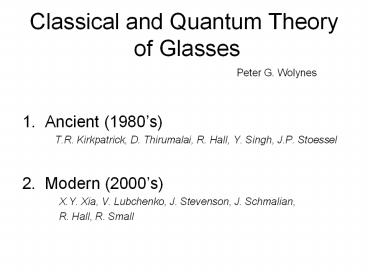Classical and Quantum Theory of Glasses - PowerPoint PPT Presentation
1 / 67
Title: Classical and Quantum Theory of Glasses
1
Classical and Quantum Theory of Glasses
Peter G. Wolynes
- 1. Ancient (1980s)
- T.R. Kirkpatrick, D. Thirumalai, R. Hall, Y.
Singh, J.P. Stoessel - 2. Modern (2000s)
- X.Y. Xia, V. Lubchenko, J. Stevenson, J.
Schmalian, - R. Hall, R. Small
2
(No Transcript)
3
The Architecture of Aperiodic Crystals
Model handbuilt by J.D. Bernal
4
(No Transcript)
5
(No Transcript)
6
(No Transcript)
7
(No Transcript)
8
(No Transcript)
9
(No Transcript)
10
Crystallization vs. Glassy Dynamics
crystallite
critical nucleus size
F
large surface cost
N
F(N) - TscN ?N1/2
Notice no energy gap.
F(N) -?ƒ N ? N2/3
(?Es - TSc),
Free energy gap
Glassy Barrier depends on Tsc alone!
Crystal nucleation barrier depends on TF - T
11
(No Transcript)
12
(No Transcript)
13
Glassy Dynamics from a Mosaic of Energy Landscapes
Temperature of Vanishing Entropy
Lubchenko and Wolynes, Annu. Rev. Phys. Chem.
2007, 85235-66.
14
RFOT predicts the non-exponentiality parameter
from fragility and thermodynamics
Mosaic picture
?
?4.5a
15
RFOT predictions of CRR size agree with experiment
Berthier et al. inequality
Berthier et al. Science (2005) 310, 1797 Data
from Bohmer et al. J. Chem. Phys. (1993) 99, 4201
16
Shapes of CRRs
- Surface interaction energy favors compact shape
- Shape entropy favors fractal shape
Small surface area
Large surface area
Gebremichael et al. J. Chem. Phys 120, 4415
17
Shape transition signals crossover temperature
Mode Coupling Transition
Log( Viscosity , P)
String Transition
Sc(Tg)/Sc
Same as Hagedorn transition in string theory!
18
Intermolecular forces and the glass transition
R.W. Hall and PGW
Self consistent phonon theory and liquid equation
of state
Plots mV and mP on the one hour time scale using
the MGC equation of state
19
nb
nb
nb
20
Explicit magnetic analogies for structural glass
-Jacob Stevenson -Rachel Small -Aleksandra
Walczak -PGW
Nucleation dynamics
Self-Consistent Phonon Theory / Density
functional Theory
F(a)
TSc
a
a
Large a frozen state
Small a liquid state
F(m)
Dynamics equivalent to random Ising system
escaping from the metastable state
lthgt
m
21
Making the mapping explicit
Free energy from self consistent phonon theory
Compare to
Recover the direct mapping
Coloring gives flipping cost. Blue is the most
stable
22
Results
Specific microscopic calculations give
The RFOT theory microscopic calculations give
Fluctuations in configurational entropy
OTP
Zero temperature phase diagram
Berkers Random Ising Magnet Phase Diagram and
structural glass analogy
Antiferromagnet
paramagnet
Spin glass higher RSB
Ferromagnet 1 step RSB
23
Vassily Lubchenko PGW, JCP (2004) 121, 2852
24
(No Transcript)
25
Non-equilibrium aging effect is predicted from
fragility within RFOT theory
26
After long-aging the mosaic is more heterogeneous
Ultra-slow relaxations
27
Confrontation of Classical RFOT Theory with
Observation
28
Some Relationships of RFOT Theory with Other
Approaches
RFOT Theory
(Microscopic) Mode Coupling Theory
Leutheusser, Götze
Phenomenological Mode Coupling Theory
Strings, Bhattacharya, Bagchi, PGW
Yes, but a higher order effect
Facilitation
Andersen, etc.
Frustrated Phase Transitions- icosahedratics, etc
Nelson, Kivelson, etc.
29
Local libraries lead to tunneling resonances
Lubchenko PGW
N ?E0
30
Density of Resonances
eltltTg
31
(No Transcript)
32
(No Transcript)
33
Direct spectroscopic evidence of complex
structure of 2LS
34
(No Transcript)
35
(No Transcript)
36
Confrontation of Quantized RFOT Theory with
Observation
37
(No Transcript)
38
Percolation clusters and strings
- The surface of percolation clusters and strings
scales with volume baN.
Percolation
Strings
39
(No Transcript)
40
(No Transcript)
41
RFOT theory predicts dynamic fragility from
thermodynamics
Dm590/(m-16)
Bohmer, Ngai, Angell, JCP, (1993)
42
RFOT theory predicts fragility parameter, m
m from RFOT
m from experiment
43
Classical and Quantum Glasses
- Energy Landscapes
- Library Construction
- Nature of cooperatively rearranging regions
- Two Level Systems as Resonances
- Boson Peak
- Electrodynamics
- Beyond Semi-Classical Theory Quantum Melting
- X.Y. Xia, UIUC/McKenzie
- Vas Lubchenko, UH
- Jake Stevenson, UCSD
- Joerg Schmalian, Iowa
- R. Silbey, MIT
44
(No Transcript)
45
(No Transcript)
46
(No Transcript)
47
(No Transcript)
48
(No Transcript)
49
pe
50
RFOT predictions of CRR size agree with experiment
- Berthier et al. derived the relationship between
the four point correlation function, ?4, and the
dynamic susceptibility - ? 4(kB/CP)T2 ?T2
- Taking this as a rough equality the size of the
cooperatively rearranging region is deduced - ?/a ((3/4p)ß2m2kB/?CP)1/3
Berthier et al. Science (2005) 310, 1797 Data
from Bohmer et al. J. Chem. Phys. (1993) 99, 4201
51
Shapes of CRRs
- Include in the nucleation theory the possibility
that the nucleating shapes be other than
spherical. - Surface interaction energy wants compact shape
- Shape entropy wants fractal shape
Small surface area
Large surface area
Gebremichael et al. J. Chem. Phys 120, 4415
52
Percolation clusters and strings
- The surface of percolation clusters and strings
scales with volume baN.
Percolation
Strings
53
Crossover temperature
54
(No Transcript)
55
(No Transcript)
56
(No Transcript)
57
Local libraries lead to tunneling resonances
Lubchenko PGW
N ?E0
58
Density of Resonances
59
(No Transcript)
60
(No Transcript)
61
Distribution of Barriers
62
(No Transcript)
63
(No Transcript)
64
Electrodynamics of Glasses
Vas Lubchenko, PGW, R. Silbey, Mol. Phys. (2005)
Two level systems possess dipole moments,
quadrupole moments, etc.
sin?dl/a
ltµ2gt µ2mol(dl/a)2(?/a)3
At lab Tg, µT µmol
65
Direct spectroscopic evidence of complex
structure of 2LS
66
Beyond the Semi-Classical Tunneling System
Quantum Melting
Level repulsion
Quantum melted modes
?
Quantum melted resonances lead to deviations from
standard tunneling model.
67
(No Transcript)































